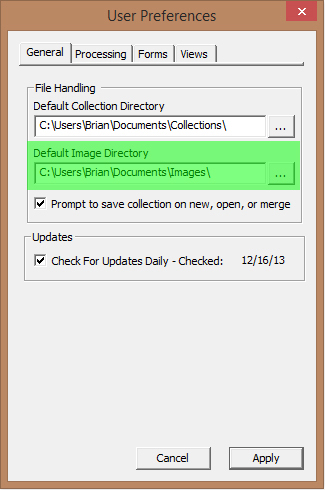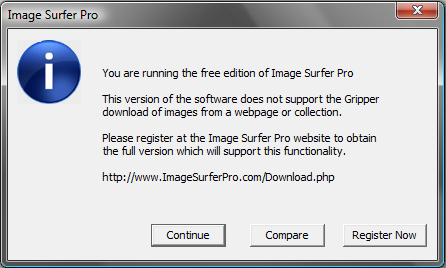 Tools & Settings
Tools & Settings
Grabbing Images
The Image Surfer Pro Grab Images tool found on the
![]() Tools & Settings menu grabs a copy of every image currently in the Internet Explorer display window and writes
them to disk. It is similar to right clicking on every image and choosing "Save Picture As...". However, this utility
has several improvements over the Internet Explorer option.
Tools & Settings menu grabs a copy of every image currently in the Internet Explorer display window and writes
them to disk. It is similar to right clicking on every image and choosing "Save Picture As...". However, this utility
has several improvements over the Internet Explorer option.
- It saves every image from the currently displayed webpage
- All of the images are saved in the directory of your choosing
- Filenames are based upon the direct URL of each image and guaranteed to be unique
Image grabbing is done in three simple steps:
- The images are downloaded to a temporary location
- You choose the final destination directory
- The image files are moved to the location you chose
Step 1: Downloading Images
Because Image Surfer Pro runs within Internet Explorer it is subject to the limitations of a low security application. This is by design and helps protect you from hazardous content encountered by Internet Explorer and Image Surfer Pro. Part of the Internet Explorer Security Suite limits the locations embedded applications may write on your hard drive. For this reason, images are downloaded to a temporary directory specific to the browser window from which you chose the Grab Images tool.

A progress window will normally appear in the bottom right corner of your desktop window showing the progress of downloading the images. The length of time it takes to download the images will depend upon the number of images being downloaded, the size of the images being downloaded, and your network connection speed. This progress bar will remain on top of your desktop but you may continue working in other windows while the download is in progress. Internet Explorer will not respond during the download progress but other applications will.
A progress window may not appear if the time it takes to download the images is less than a couple of seconds. This may happen even if the images are large and numerous if the images are directly stored in the Internet Explorer cache and easily accessible.
Step 2: Choosing the Destination
The standard windows file browser is provided for you to choose the destination directory. The top most directory where browsing starts is determined by your user preferences. You need not select a file, just navigate to to the directory where you wish to save the image files and click "Open".
If you cancel or close the file explorer window rather than clicking "Open" the file will not be transfered and will remain in the temporary location until the Internet Explorer tab associated with the images is closed - at which time they will be deleted along with the temporary visualization files created by Image Surfer Pro.
Step 3: Moving Files to Destination
The images will be moved silently from the temporary location where they were downloaded in Step 1 to the direcory you choose in Step 2. You may continue browsing while the move is in progress.
Each image file is given a name based on the fully qualified URL from which the image was downloaded. Each "/" is in the URL is replaced by a ".". This allows images from different locations to be saved in the same local directory with a clear indication of where each came from and avoids accidently overwriting an image with the same file name but from a different web location.




